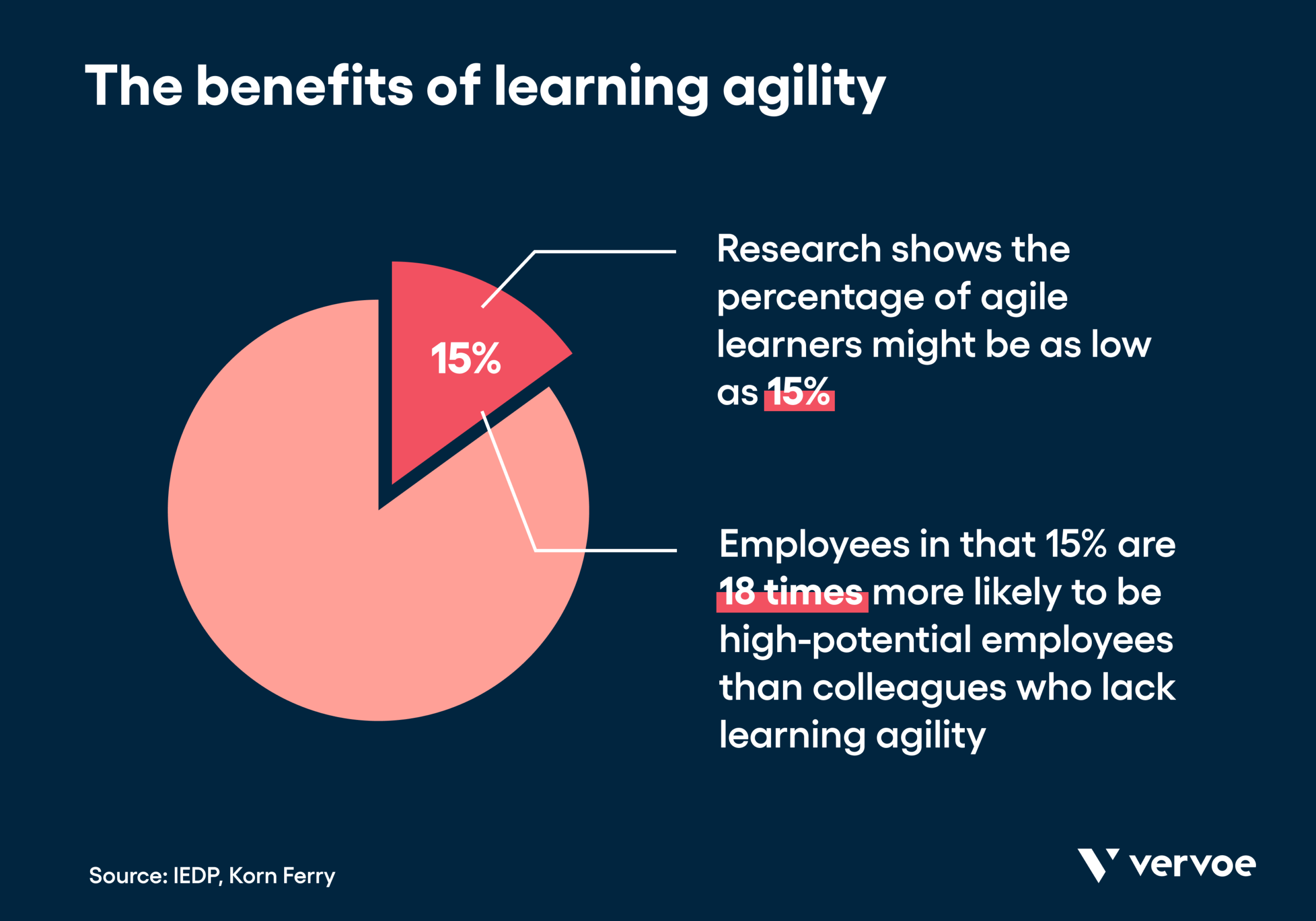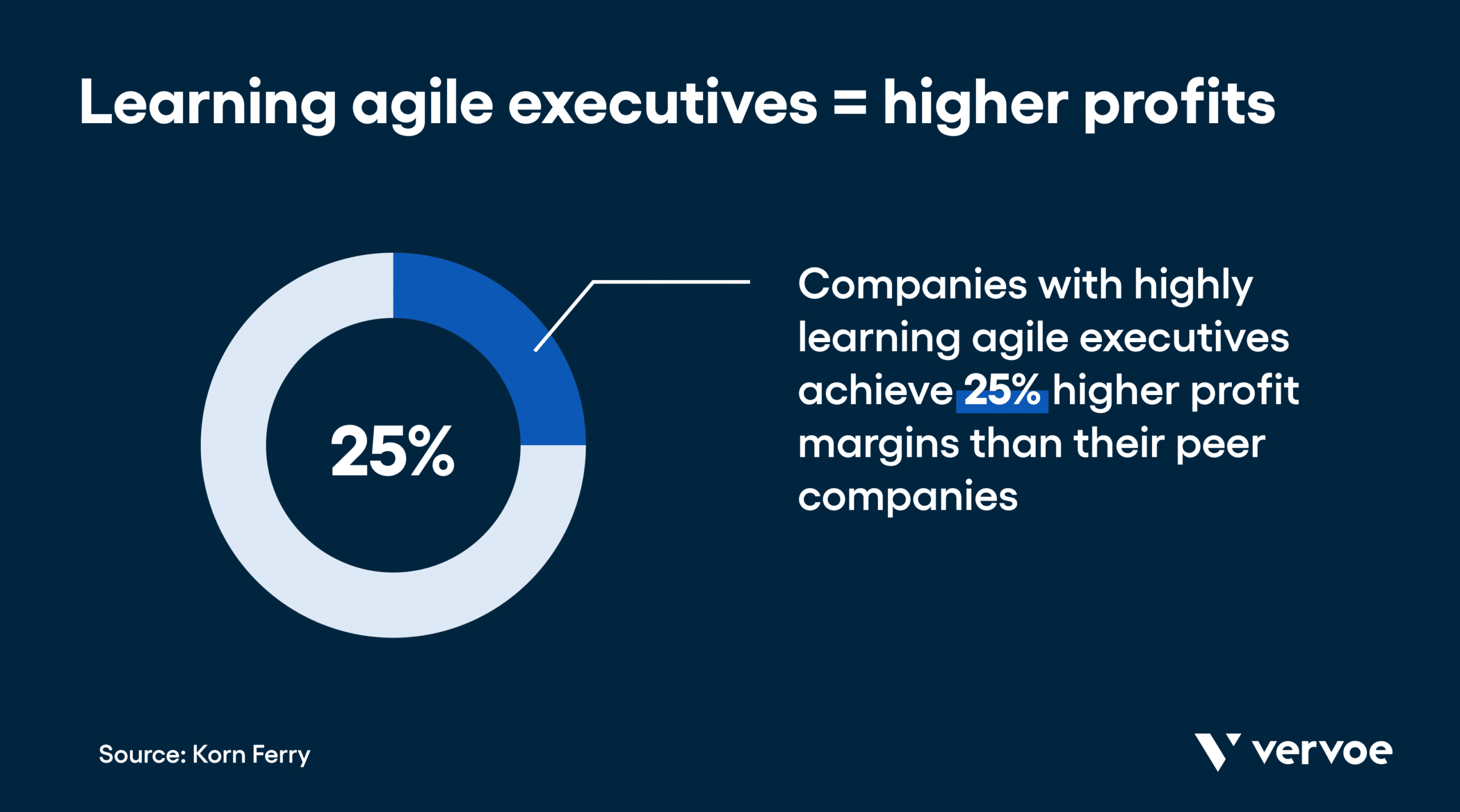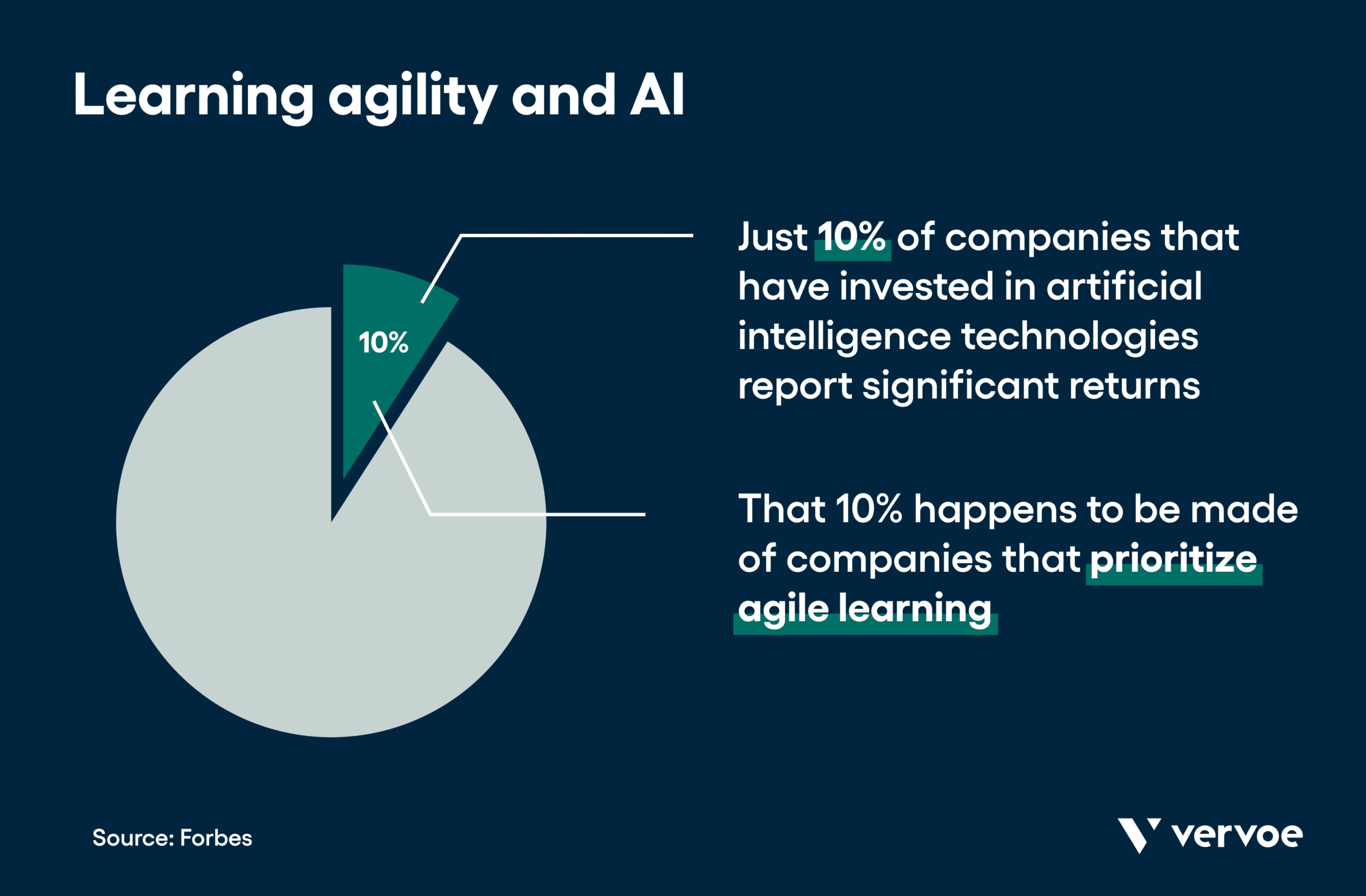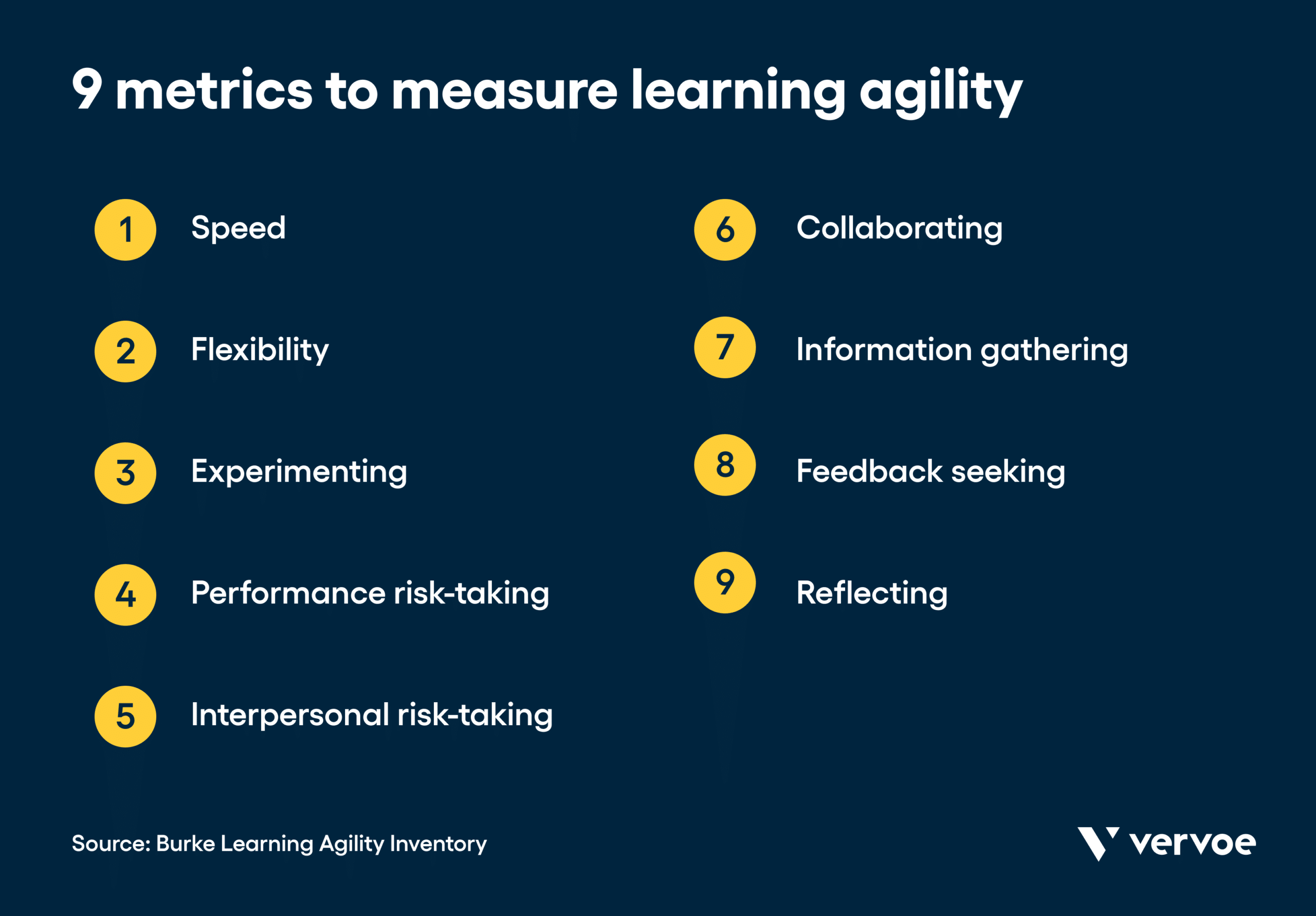We all know that prior experience makes potential candidates more attractive, but have you ever wondered why? Even experience in an indirectly related role can make for a successful new hire.
It’s not necessarily because they’ve done the job before, but rather that they know how to apply their past experiences to solve unfamiliar problems.
This is a skill. It’s called learning agility, and not everyone has it.
Research shows the percentage of agile learners might be as low as 15%.
Organizations that wish to stay competitive in today’s dynamic world need to fill their teams with agile learners.

What is learning agility?
Learning agility is the act of adapting to an unfamiliar situation. If you want a simple learning agility definition, think of it as figuring out what to do when you don’t know what to do.
It’s overcoming business obstacles you’ve never encountered before without a roadmap to guide you.
Business is unpredictable. There are a lot of moving parts and people are people, not bullet points on a template. Successful candidates must have the ability to take what they’ve learned about how business should operate and adapt that framework for success in the real world.
That’s learning agility. It comes from a blend of curiosity, analysis, and problem-solving skills. Candidates who display learning agility are passionate about expanding their skillset, soaking in learning opportunities with each new experience, and embracing change as it’s thrown their way.
These candidates are excited about finding new ways to work through challenges. Uncertainty might scare them (as it does most everyone), but they use this discomfort to fuel the problem-solving actions they use to overcome the challenge at hand.
Employees with learning agility set ambitious goals in the workplace and do what they have to do to achieve them.
Think of learning agility as the secret ingredient to success in your organization.
Consider, for example, 2020, when companies with agile employees were more likely to succeed in a remote setting, finding new ways to make up for or prevent lost revenue.
With a team full of agile employees, you achieve the enterprise agility necessary to weather any storm.
What does it mean to have learning agility?
Learning agility shows how people navigate unfamiliar and sometimes difficult circumstances. It’s how you act when you have to accomplish something you haven’t done in the past.
Using a bank of knowledge and experiences, learning agile people devise a plan for overcoming and making the most out of unforeseen obstacles.
Those with learning agility usually have to be open-minded. If you think you know everything already, you won’t be open to learning new things. The ability, willingness, and desire to learn new things are the core of learning agility.
The world is rapidly changing. Not only are we encountering new environmental obstacles like the Covid-19 pandemic, climate change, and more, we’re also experiencing constant innovation in technology and the workplace.
Agile learners strive to evolve with the times. They don’t shy away from implementing new technologies and innovations in an effort to overcome challenges and improve business processes.
What are the different dimensions of learning agility?

According to research by Korn and Ferry, learning agility presents itself in 7 distinct profiles:
- Problem-solvers
- Thought leaders
- Trailblazers
- Champions
- Pillars
- Diplomats
- Energizers
These learning agility examples seek out experiences to learn from, enjoy making sense of and solving complex problems, and display better performance overall because they are constantly acquiring new skills.
These five dimensions are the building blocks of learning agility in all profiles:
- Mental agility – this is the ability to embrace difficult situations, examine problems with a curious, creative eye, and make interdisciplinary connections. People who display mental agility are excited when they encounter complex issues, taking joy in the opportunity to solve them and learn from the experience.
- People agility – open-mindedness and the desire to interact with and learn from diverse groups of people. Those who display people agility are more likely to connect with people with different backgrounds and opinions. They act constructively toward their peers and prioritize listening to and understanding what others have to say.
- Change agility – the desire to evoke change by setting ambitious goals and investigating newer, more efficient ways of doing business. Those who display change agility are inherently curious and experimental. They seek out new ways of doing things and are excited by new experiences.
- Results agility – the ability to produce positive results amidst challenging situations. Those who display results agility are willing to do almost anything to be successful. They’re always hunting down new ways to improve their results and tend to thrive under pressure.
- Self-awareness – willingness to look inward, examine one’s strengths and weaknesses, appreciate feedback, and acknowledge that there is always more to learn. These are the people who actively try to understand how they can improve their performance on a regular basis. People who display self-awareness are more likely to meet the other four criteria.
Why learning agility is an important skill for work
Learning agility is an essential skill for employees wishing to learn and grow with their company. Organizations with high levels of learning agility experience better employee productivity, more high-potential employees, and an increase in overall profitability.
In order to adapt and grow as an organization, you need workers who are willing and able to do the same. If they aren’t, you’ll end up having to spend valuable time and money finding and replacing employees who can’t keep up with your new direction — that will hold your organization back.
Consider this scenario: Your tried and true social media manager is reluctant to learn about TikTok and Instagram Reels, but everywhere you look you’re seeing that short video is the future of social media marketing.
If you want to adopt a TikTok marketing strategy, you’ll have to find another social media manager or add on a team member dedicated to TikTok.
Finding, hiring, and training a new candidate is going to take time and money that you wouldn’t have to shell out if you had a social media manager who jumped at the opportunity to adopt new strategies.
Learning agility doesn’t just benefit the organization, though. Encouraging learning agility among your team members will help their careers long term.
Agile employees develop the skills and drive necessary for long-term success in their industry. Being learning agile makes employees competitive for new opportunities in and outside your organization.
Fostering an environment that encourages learning agility can also help employees deal with hurdles thrown their way outside the workplace. The ability to adapt and overcome complex situations can improve the way people act in relationships.
How learning agility can impact your business
So, what does learning agility mean for your business? It keeps your organization up to speed with the current market standards.
Prioritizing learning agility ensures that every new hire is a solid investment for the organization. These are the employees with the leadership skills to push your organization to greater heights.
According to Korn Ferry, companies with highly learning agile executives achieve 25% higher profit margins than their peer companies.

Open-minded employees at agile organizations don’t limit themselves to internal trends and data. Rather, they widen their perspectives to examine the state of data in the greater market, gathering new insights that inspire change within the organization.
You might be adopting innovative technology as a company, but that won’t help your organization if you lack a team of agile learners.
Just 10% of companies that have invested in artificial intelligence technologies report significant returns. That 10% happens to be made of companies that prioritize agile learning.
Instead of paying out the nose for data scientists and technology, they adjusted their business processes to support and benefit from AI.
Learning agility is crucial to the success of your business. You can make all the changes you want, but if you lack a team willing and able to change with you, benefiting from those changes as an organization will be a struggle.

How to measure learning agility

According to the Burke Learning Agility Inventory, here are nine indicators of measuring learning agility:
Speed
Agile learners are quick to act on new ideas. This speed allows them to move through more opportunities while equipping them to pivot and grow at a rapid pace.
Flexibility
Flexibility is a key quality of an agile learner. Learning agility requires candidates to be flexible according to their environment, changes within the industry, new goals, and growing expectations.
Experimenting
Agile learners tend to experiment with new processes to find the most efficient, profitable way of doing things.
Performance risk-taking
Learning agility requires candidates to leave their comfort zone, seeking out new challenges. This quality builds a diverse bank of experiences agile learners use to solve new, complex problems.
Interpersonal risk-taking
An agile learner’s tendency to discuss differences and explore varying worldviews, challenging their thought processes in a way that promotes growth and learning. It also encompasses an agile learner’s willingness to acknowledge when they are wrong and learn from their mistakes.
Collaborating
Agile learners are always on the lookout for collaborative opportunities that will help them learn and grow. They soak in all they can learn from observing other working styles and are willing to accept help from others to achieve their ultimate goals.
Information gathering
Learning agility requires employees to remain up-to-date on relevant current events and the status of their industry. They must constantly be searching for ways to grow their skillset.
Feedback seeking
Agile learners know that they have room to learn and grow. They seek feedback on their performance and use that feedback to improve.
Reflecting
This plays into the self-awareness of learning agility. Agile learners need the ability to stop and look back on their behavior and actions, assess their performance, and identify areas for improvement.
How to assess learning agility
Learning agility deserves a permanent home in your recruiting process. So, how do you make sure you’re hiring learning agile employees?
Consider a learning agility assessment test
Learning agility isn’t always the easiest quality to quantify in an interview. Luckily, there are assessments, like ours, that do that work for you.
You can find assessments tailored to specific positions that test learning agility as one of their components. Different positions require different levels of learning agility. Your leadership team needs to be more agile than the average employee.
Learning agility assessment tests proven by science and data are your best bet for assessing a candidate’s learning agility.
Check cognitive ability
You can’t rely on cognitive ability as the sole indicator of learning agility, but a certain level of cognitive ability and learning agility can go hand in hand. With that said, you can use a candidate’s cognitive ability as a pre-indicator for learning agility.
Tweak your interview questions
Targeted interview questions can also help you assess a candidate’s learning agility. Read over the above tips for how to measure learning agility and use those to create a learning agility questionnaire relevant to the role you’re hiring for.
Need a learning agility test example? You might ask a candidate how they adapted to a change at their previous role or how they receive feedback. You can even create situational interview questions that indicate how a candidate would display learning agility in their new role.
Final thoughts
Change is a constant we can count on. To stay successful in a society that’s constantly evolving, the ability to learn and adapt is crucial.
The best candidates are those with a strong desire and willingness to learn and grow. You need a team full of employees keeping up with the latest tech and trends, ready to pivot whenever and wherever the industry takes them.
Ready to implement learning agility into your recruitment process? Our Problem Solving Skills Assessment will help you examine the learning agility, problem-solving skills, and trainability of potential candidates.





















